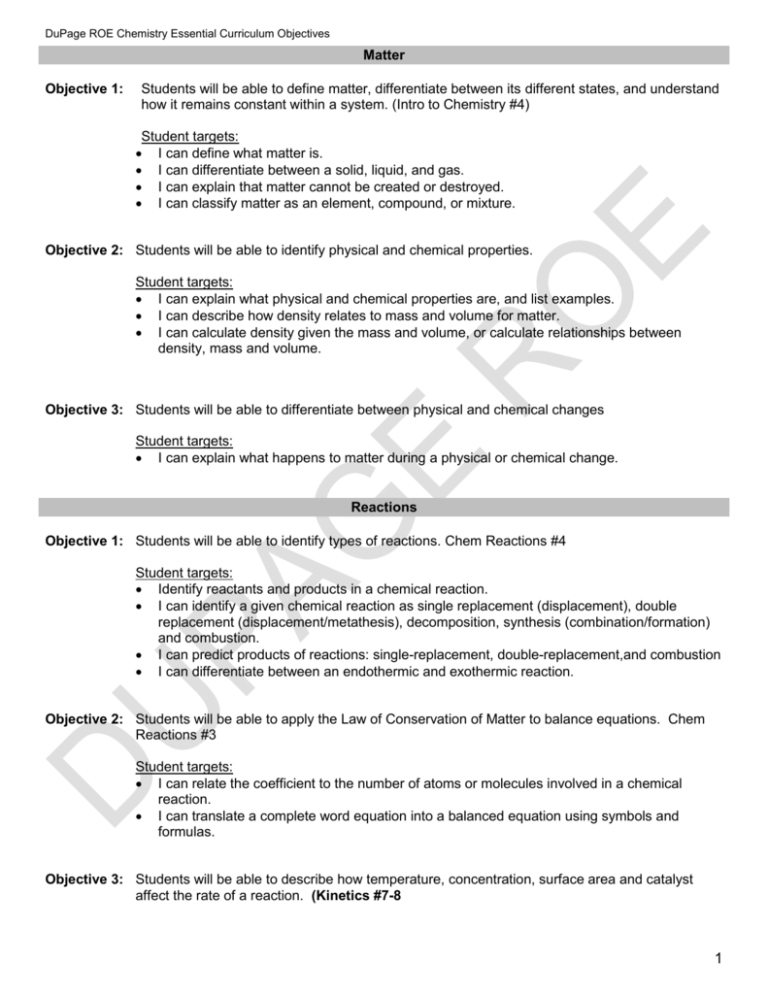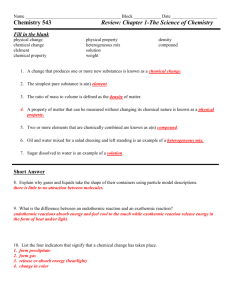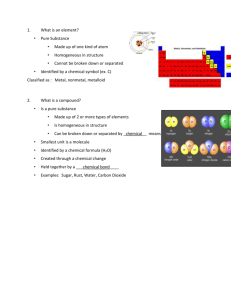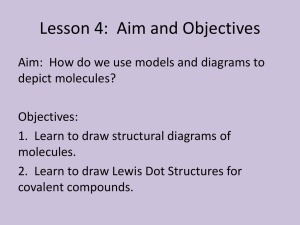Matter
advertisement

DuPage ROE Chemistry Essential Curriculum Objectives Matter Objective 1: Students will be able to define matter, differentiate between its different states, and understand how it remains constant within a system. (Intro to Chemistry #4) Student targets: I can define what matter is. I can differentiate between a solid, liquid, and gas. I can explain that matter cannot be created or destroyed. I can classify matter as an element, compound, or mixture. Objective 2: Students will be able to identify physical and chemical properties. Student targets: I can explain what physical and chemical properties are, and list examples. I can describe how density relates to mass and volume for matter. I can calculate density given the mass and volume, or calculate relationships between density, mass and volume. Objective 3: Students will be able to differentiate between physical and chemical changes Student targets: I can explain what happens to matter during a physical or chemical change. Reactions Objective 1: Students will be able to identify types of reactions. Chem Reactions #4 Student targets: Identify reactants and products in a chemical reaction. I can identify a given chemical reaction as single replacement (displacement), double replacement (displacement/metathesis), decomposition, synthesis (combination/formation) and combustion. I can predict products of reactions: single-replacement, double-replacement,and combustion I can differentiate between an endothermic and exothermic reaction. Objective 2: Students will be able to apply the Law of Conservation of Matter to balance equations. Chem Reactions #3 Student targets: I can relate the coefficient to the number of atoms or molecules involved in a chemical reaction. I can translate a complete word equation into a balanced equation using symbols and formulas. Objective 3: Students will be able to describe how temperature, concentration, surface area and catalyst affect the rate of a reaction. (Kinetics #7-8 1 DuPage ROE Chemistry Essential Curriculum Objectives Acids and Bases Objective 1: Students will be able to identify and define acids and bases. Student targets: I can describe physical properties of acids and bases. (Operational definition- sour, bitter, slippery, litmus paper change) I can identify an acid as producing hydrogen ions in solution and a base as producing hydroxide ions in solution according to the Arrhenius definition. I can identify an acid as a proton donor and a base as a proton acceptor according to the Bronsted-Lowry definition. I know the purpose of an acid/base indicator. Objective 2: Students will be able to relate hydrogen ion concentration to the hydroxide ion concentration and the pH scale. Student targets: I can explain that water auto-ionizes and describe the process through the reaction equation H2O(l) H+(aq) + OH-(aq) I can show that there is an inverse relationship between [H+] and [OH-] I can determine the pH of a solution using the relationship pH = -log[H+] and pH + pOH = 14. I can infer that as pH goes up, hydrogen ion concentration is decreasing. I can correctly interpret whether a solution is acidic, basic or neutral depending upon the pH value. Objective 3: Students will be able to explain acid-base neutralization reactions. Student targets: I can predict the products of an acid-base neutralization reaction Moles and Stoichiometry Objective 1: Students will be able to use the mole concept to quantify matter. Student targets: I can apply the mole concept to convert between volume, mass, and particles. I can define the mole in terms of 6.02 x 1023 (Avogadro’s number) particles I can calculate molar mass. I can calculate with molar mass and molar volume. Objective 2: Students will calculate percent composition of an element in a compound. Objective 3: Students will be able to use stoichiometry to interpret reactions in terms mass, volume, particles and moles. Student targets: I can interpret a chemical equation and the relationship of coefficients to the mole concept. I can predict the quantity of product from given reactants or vice versa. 2 DuPage ROE Chemistry Essential Curriculum Objectives Measurement Objective 1: Students will be able to gather, interpret and analyze data to draw conclusions. Measurement #2, 3,4 5 Student targets: I can recognize the uncertainty of measurements. I can choose and use appropriate lab equipment to measure properly. I can choose appropriate SI units and convert between them. I can evaluate the precision and accuracy of measurements. I can use scientific notation and interpret the meaning of the power of ten. (For example, knowing that 10-6 is smaller than 10-2). Solutions Objective 1: Students will be able to recognize and describe the characteristics and formation of solutions. Student targets: I can differentiate between solute & solvent. I can differentiate between electrolyte & nonelectrolyte. I can determine if a given solution is unsaturated, saturated, or supersaturated. I can interpret a solubility curve. (quant?) I can determine if a given solute will be soluble in a given solvent (like dissolves like). I can describe the effect of a solute on the freezing point and boiling point of water. I can predict how factors (such as stirring, temperature, surface area) affect the dissolution rate. I can compare the concentration of solutions when given information in ppm or ppb. Objective 2: Students will be able to quantitatively describe characteristics and formation of a solution. Student targets: I can calculate the molarity of a solution. I can calculate the percent composition (percent my mass) of a given solution. Gas Laws Objective 1: Students will be able to apply the kinetic molecular theory to describe the motion of atoms and molecules and explain the properties of gases. Student targets: I can explain the basic principles of the kinetic molecular theory. I can relate the constant, random motion of molecules to the volume a gas will occupy. I can explain how the interaction between gas molecules and the sides of a closed container creates gas pressure. I can explain how the distance between gas molecules explains why it is easy to compress a gas. I can explain the relationship between temperature and the average kinetic energy of gas molecules. I can understand that there is no temperature below “absolute zero” because at absolute zero there is no motion of molecules. I can explain how when one condition (P, T, V, n) changes in a gas, the others change in response. 3 DuPage ROE Chemistry Essential Curriculum Objectives Objective 2: Students will be able to logically solve problems using the gas laws to explain the relationships between pressure, temperature, and volume of any amount of an ideal gas or mixtures of gases. Student targets: I can use the values of STP to solve gas law problems. I can convert between Celsius and Kelvin temperatures. I can interpret graphical data that illustrate the relationship between P, T, V and n. Given a set of conditions, I can use the most appropriate mathematical equation to calculate a change in P, T, V, or n. Bonding Objective 1: Students will be able to describe characteristics of an ionic compound and how an ionic bond forms at an atomic level. (Bonding #1 & 2) Student targets: I can explain how ions are formed from metals and nonmetals. I can apply octet rule and rules of electrostatic attraction to explain ionic bond formation. I can describe the general characteristics of an ionic compound (solubility, melting point, alternating ions create a simple crystalline structure, electrical conductivity). Objective 2: Students will be able to describe characteristics of a molecular compound and how a covalent bond forms at an atomic level. (Bonding #1 & 2) Student targets: I can describe how a covalent bond forms at an atomic level (sharing electrons, multiple bonds, octet rule). I can describe the general characteristics of a molecular compound (melting and boiling points as they relate to intermolecular forces). I can draw electron dot diagram (Lewis dot diagrams). I can predict the shape of a molecule using VSEPR theory (linear, tetrahedral, pyramidal, bent, trigonal planar). I can explain and predict the polarity of molecules Periodic Table Objective 1: Students should be able to summarize the periodic law and explain how relates to physical and chemical properties. (Periodic Table #1, 2, 3) Student targets: I know that the periodic table is organized into 7 periods (horizontal rows) and 18 groups (vertical columns). I can locate metals, non-metals and metalloids on the periodic table I can list properties of metals, non metals and metalloids. I can identify and recall the key properties of the following families: Alkali Metals, AlkalineEarth Metals, Halogens, and Noble Gases. I can identify transition elements and rare-earth elements (inner transition, lanthanide, actinide). I can describe that hydrogen is unique and not a part of any family. 4 DuPage ROE Chemistry Essential Curriculum Objectives Objective 2: Students will be able to use the periodic table as a reference tool. Student targets: I can determine the charge of a main block (representative) ion. I can compare the radius of atoms and ions. I can determine the number of valence electrons for a main block (representative) element. Nomenclature and Lab Safety Objective 1: Students wil be able to use IUPAC naming rules to name or write the formula for a given compound (ionic, molecular). Objective 2: Students will be able to identify common acids from a given formula (hydrochloric, nitric, sulfuric, ethanoic/acetic) Acids and Bases #4 Objective 3: Students will be able to apply common safety rules and use equipment in a given lab situation. Atomic Structure Objective 1: Students will be able to dentify the location, charge and relative mass of each subatomic particle (electron, neutron, proton). Atoms #3 Objective 2: Students will be able to predict the number of protons, electrons and neutrons in a neutral atom, ion and isotope. Atoms #6 Objective 3: Students will be able to describe the relationship between absorbed and emitted energy and the emission of light as an electron transitions between energy levels,. Electrons in Atomis #6 Energy Objective 1: Students will be able to distinguish between chemical potential energy and kinetic energy. Objective 2: Students will be able to distinguish between temperature and heat. Student targets: I can recognize the units of energy: joules, calories I can use specific heat capacity to explain changes in temperature of a substance. Objective 3: Students will be able to recognize that in all processes, energy will be conserved. (Law of Conservation of Energy) 5 DuPage ROE Chemistry Essential Curriculum Objectives Objective 4: Students will be able to describe energy transfer in a physical change. Student targets: I can identify exothermic and endothermic processes. I can identify melting, vaporization and sublimation as endothermic processes. I can identify freezing and condensation as exothermic processes. Objective 5: Students will be able to describe energy transfer in a reaction. (Kinetics #9) Student targets: I can interpret a potential energy diagram to determine energy change. I can interpret a potential energy diagram to classify a reaction as endothermic or exothermic. I can label a potential energy diagram for activation energy, reactant, and products. I can describe activation energy. I can predict the effect of a catalyst on a potential energy diagram. 6








